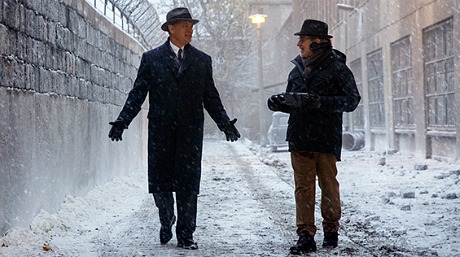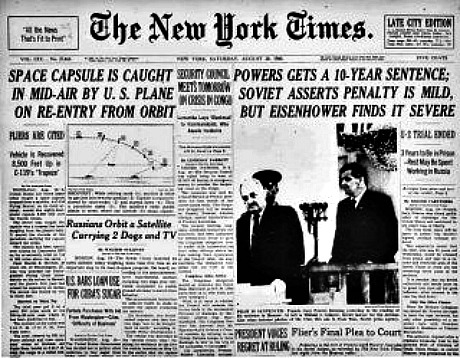What are the boilerplate signatures of a Steven Spielberg period drama? I don’t know if there’s a list but you can definitely feel the hand of the guy who made Catch Me If You Can and The Terminal (which also starred Tom Hanks), not to mention Lincoln and Munich. There’s a certain feeling of compression and urgency, a sense that the high-stakes political melodrama that actually unfolded in the late ’50s was quite the nail-biting drama of its time. The atmosphere feels pushed, exaggerated. And Spielberg’s “house” dp Janusz Kaminski is back with his deep blacks and milky blue tints. But no John Williams score this time due to surgery — Thomas Newman is filling his shoes.
Bridge of Spies (Disney/Touchstone, 10.16) refers to a famous bridge used by the Americans and Soviets for exchange of captured spies during the Cold War. Spielberg’s film is about the U-2 spy plane incident of May 1960 when CIA surveillance pilot Francis Gary Powers was shot down by the Soviets. Powers was sentenced to ten years in the slam but American lawyer James Donovan (Tom Hanks) eventually negotiated his release.
On 2.10.62 a Glienicke Bridge swap happened with Powers exchanged for Soviet spy Colonel Rudolf Abel.
John Le Carre‘s Karla, the senior Soviet intelligence officer who was the prime antagonist of George Smiley, defected across the Glienicke bridge, which spanned between West Berlin and the former Eastern bloc suburb of Potsdam.
Are you sensing from all this what Bridges of Spies is going to be like? It’s going to be some kind of respectable HBO-level period drama in which this happens and then that happens and then this happens and then that happens, and then Hanks finally arranges for the swap and Powers is finally free.

Tom Hanks, Steven Spielberg during filming of Bridge of Spies.










